Introduction
On orbit servicing; a technology whos time has come. While there is a history of on orbit servicing stretching in concept to the 1950’s and in actuality to Shuttle missions of the 1980’s, this missive will only cover the last 15 years or so, since the possibility of a commercial on orbit servicing business. Here I will lay out that recent history and then segue to the current controversy between DARPA’s Robotic Servicing of Geosynchronous Satellites (RSGS) vs Orbital ATK’s Mission Extension Vehicle (MEV) and our own system Orbital Logistics Vehicle (OLV) which is conceptually similar to the MEV.
The essence of the controversy is that the DARPA RSGS vehicle is an inappropriate government subsidized competitor to the MEV and by extension the OLV. It will be argued here that this is not really the case as the concept and potential customers of the RSGS is distinct from the MEV/OLV. However, this is not a good thing in that the RSGS is a very bad fit in the market place due to its high cost, short lifetime, and the episodic nature of its potential customers. Indeed it can be argued that, at this time, the RSGS is the anti-example of an on orbit servicing system for geosynchronous satellites.
Recent History
Background
“On orbit servicing” can best be defined for the purposes here as the activity where one satellite services another one. “Services” is defined as any activity whereby one satellite (the “servicer” )does anything to another satellite to repair, refurbish, refuel, repurpose, or provide any other type of aid that extends, compliments, or salvages the operation of the client vehicle. The “client” is defined as the satellite being serviced.
History—2000’s
This is by no means an exhaustive history but the efforts outlined will give a general flavor of what was going on in the first decade of the 21st century.
Vanguard Space Corporation
The first one that I was aware of that was serious about developing and operating an on orbit servicing system was the Vanguard Space Corporation. The Vanguard Space Corporation was started by Apollo 15 astronaut David Scott. He was able to gain several patents in the arena of on orbit servicing but Vanguard was never able to get commercial or government traction due to the high cost of his solution. However, some good fundamental work was undertaken to understand the GEO satellite market and to realize that this is where the money was.
Orbital Recovery
In 2002, I was involved in the founding of an on orbit servicing company called Orbital Recovery. The founding concept was to build “the minimum viable on orbit servicing system for the marketplace in GEO orbit”. The problem that we had identified in starting the company was that the Vanguard effort, as well as NASA’s and other government backed efforts were too expensive for the market place. We were also a completely commercial enterprise, focused only on commercial GEO satellite operators. If the government wanted to purchase it would be on the same terms.
We went through two iterations of our system, the first with European government support with a 50/50 public private partnership. That resulted in a system that was too expensive for the market place. We went through a second iteration, without government support that resulted in a much less expensive system, based on a Swedish Space Corporation science spacecraft called SMART-1. This version was much less expensive and even then just barely commercially viable. We did sign the world’s first commercial on orbit servicing contracts with multiple GEO satellite operators. However, we were beset with extraordinary events when our lead investor was jailed for tax evasion and then the economic crash of 2008.
NASA
NASA in the 2000’s was continuing to work on various on orbit servicing ideas and missions. NASA Goddard Spaceflight Center and Frank Cepolina had led the effort to successfully service the Hubble telescope, with multiple missions in the 2000’s to repair and refurbish the telescope. This used the NASA space shuttle to accomplish. The costs of these missions can be argued in many ways as a being horrendously costly but they were an exceptional demonstration of capability. The horrendous cost however, precluded any possibility that the process would be used outside of the government.
NASA DART
NASA had another mission in 2005 to test out rendezvous and proximity operations called the “Demonstration of Autonomous Rendezvous Technology” or DART. This was a $110m dollar epic failure, built by Orbital Sciences. The spacecraft went off course when it got close to the DARPA MUBULCOM satellite and actually rammed it. The mission was cut short and a scathing report regarding the failure was released. The main report was embargoed under ITAR but informed sources indicate that it was a very poorly executed mission. This $110m dollar failure did little to build confidence in on orbit servicing.
DARPA–Orbital Express
DARPA flew the Orbital Express mission in 2007. The purpose of which was to test several technologies that could be used to refuel and possibly repair or upgrade client satellites in the future. We (Orbital Recovery) was asked about this by customers many times. Their questions revolved around the cost of Orbital Express and why we thought that ours would be much cheaper. Indeed we began to call Orbital Express the anti-technology demonstration for on orbit servicing. This was at least partially because the original contract for Orbital Express was little more than $100m dollars. However, before it flew, the prime contractor Boeing, along with DARPA, had allowed the costs to explode to well over $336 million dollars. The Orbital Express satellites were deactivated and eventually de-orbited. There was no measurable impact on bringing satellite servicing to market for government or commercial customers.
Post 2010 On Orbit Servicing Missions
McDonald Detweiler
McDonald Detweiler or MDA, is a first class Canadian satellite systems company who has been a long time player in space robotics. They built the Space Shuttle and the International Space Station remote manipulator systems. They sought to look beyond the government customer to commercial on orbit servicing. In 2010 they announced their Space Infrastructure System and in 2011 a deal with Intelsat for servicing its large GEO fleet.
This deal was later scuttled by both parties. The claim was that DARPA and its efforts were unfair competition with MDA. This is from the linked Wikipedia article:
As of November 2011, MDA suspended the satellite servicing mission while awaiting major decisions due soon on the scope and details on planned satellite servicing missions by US government civilian and defence agencies NASA and DARPA. MDA wants to “see the NASA and DARPA bid requests, see what’s in them, whether [MDA] can bid as a Canadian company, or as a U.S. company.”[3] MDA Chief Executive Officer Daniel E. Friedmann said “We can’t just go ahead. I know everybody says the government is not a competitor, and yes, literally they are not a competitor. But our whole business is about winning business from the government and then taking that dual-use technology into the commercial market.”[3]
It is more likely that the mission was non viable without a government subsidy as is alluded to in the last sentence of the quote.
Vivisat
After the demise of Orbital Recovery, ATK came to us to license the patent that underpinned the Orbital Recovery concept. This was done and the Vivsat project was born. It had the same virtues of the original Orbital Recovery project, which was a system that would extend the life of GEO satellites with a simple mechanical connection. The vehicle would then take over the attitude control and propulsion of the coupled system. This is what we called the minimum viable on orbit servicing concept.
The problem with the Vivsat construct was that the business construct for developing the system was flawed. Large corporations that are government contractors rarely can be counted on to build cost effective systems. The concept languished until the merger of ATK and Orbital Sciences in 2015.
Orbital ATK MEV
The MEV gained new life after the merger between Orbital Sciences and ATK. Once again our patent was licensed to the new entity and in April of 2016 a contract was signed between Intelsat and the new Space Logistics LLC company, wholly owned by Orbital ATK. Only time will tell if they are going to be successful after a lawsuit between them and their former partners U.S. Space LLC. However, the commercial GEO satellite focus with the minimal viable on orbit servicing system has led to a fully commercial contract, something that none of the other efforts based on more complex servicing has consummated.
Skycorp OLV
We have continued our own development in this area since the demise of Orbital Recovery with a focus on reducing cost and maintaining the philosophy of the minimum viable on orbit servicing system. We have had extensive discussions with the satellite operator community and we understand the state of the market today. This market is shifting in ways that were never dreamed of 10 years ago. The system cost that ten years ago was minimally viable as a business may not now be sufficiently low in the changed circumstances of today. The GEO satellite business is under enormous pressure to reduce costs and thus even more radical approaches may be necessary. This has been the direction that we are already going, and thus the future is very interesting in this area.
Effective Space Solutions
A new entrant from Israel is Effective Space Solutions. They are also looking to provide a minimally viable on orbit servicing system. Not too much more can be said about their efforts here other than that the overall philosophy of developing the lowest possible cost system that can meet a market need is the only path forward in the commercial market.
DARPA RSGS
The DARPA RSGS system is fundamentally different than the heritage that started with Orbital Recovery and much closer in concept to previous DARPA efforts in the Phoenix program and going back to the Orbital Express technical demo in 2007. The fundamental philosophy is not toward a minimal viable system but for a system that is far more technically complex and thus more expensive system. From the DARPA presentation on the subject from the industry proposers day.
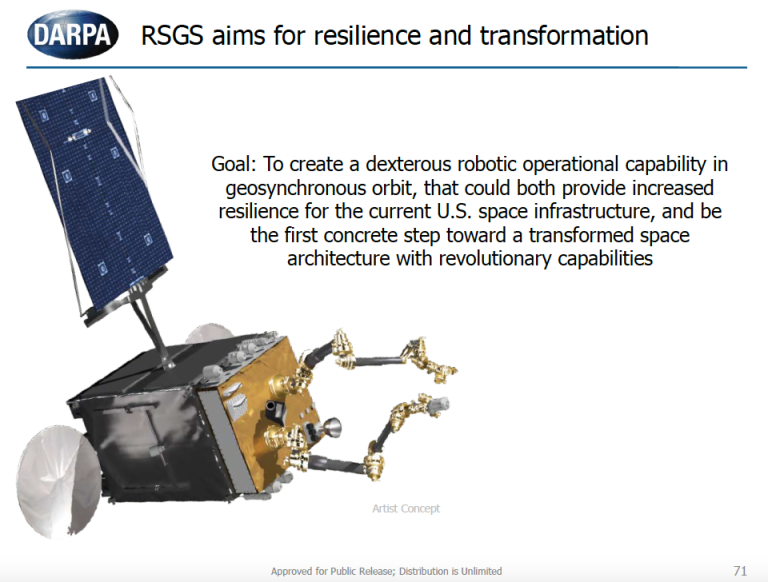
Thus it can easily be seen from their goals, which are to create “revolutionary capabilities” puts it in a completely different class than the Orbital ATK, Skycorp, or Effective Space Solutions offerings. Here is another slide that shows all the cool stuff that it can do.
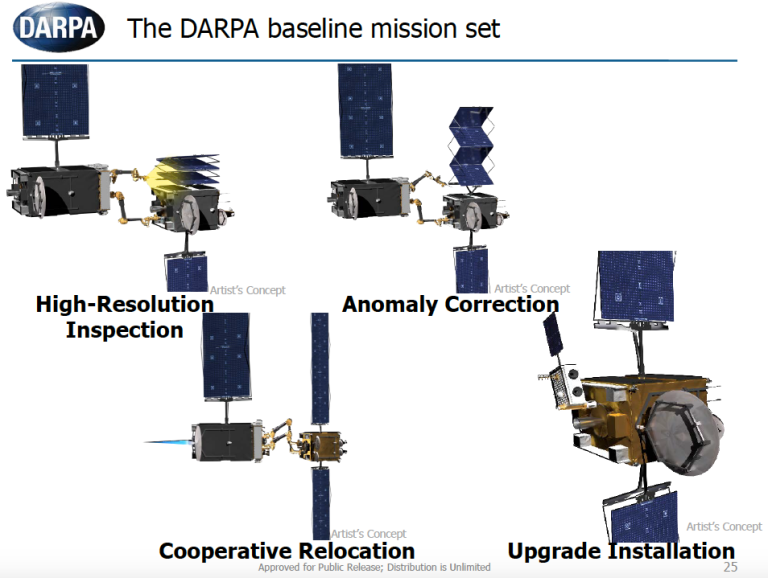
Some of the capabilities above are not even in existence yet and are unlikely to be so in any wide sense before the demise of the vehicle 5-8 years after launch. DARPA actually has a very expansive and laudable vision, as is shown here in this slide.
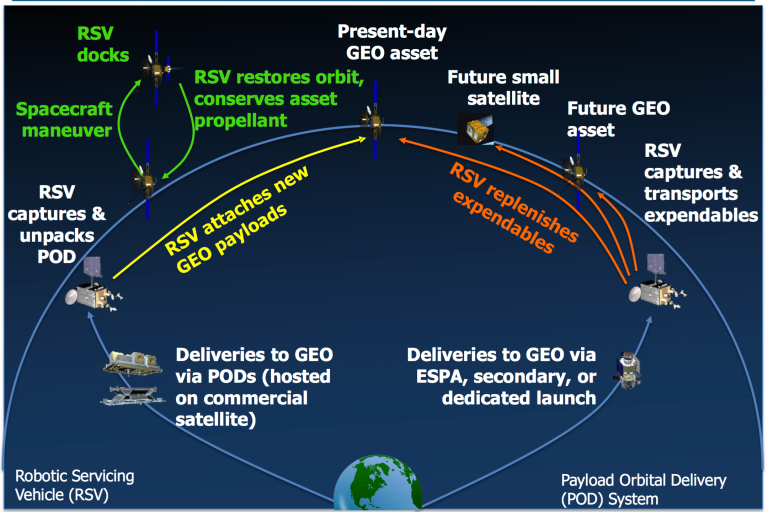
These are laudable goals. DARPA hopes to bring down the cost of the initial RSGS system by requiring a buy in from potential contractors. However, this is a double edged sword as DARPA also levied these requirements that basically negate all the good ideas.

The problem here is that there is a fundamental conflict of interest between those that build the busses and those that build the servicing system. Even though DARPA has gone a long way to basically require that team members bring something to the table, the project is still vulnerable to the same philosophical problem that made Orbital Express a technical success yet failure in moving the ball forward in on orbit servicing. The first problem is that it is doubtful that the contractors will have any more incentive to control costs this time as they did with the 3X cost growth of Orbital Express.
Secondly, the same type of situation could occur as happens with European public private partnerships and our own first effort with Orbital Recovery, which is that the contractors have it in their heads that the government won’t want this to fail so will continue to pony up funds for overruns. The final problem problem is trying to build a system that tries to do all the tasks that on orbit servicing would like to have as a mature industry. We have had this argument with DARPA program managers and former program managers and they simply refuse to allow that this might be the case. However, the simple fact is that the satellite operators don’t care that your system is “revolutionary”. They care that you can solve a problem for them for a lower cost than other alternatives. It really is that simple.
The Controversy
It was reported in Space News on January 25th, 2017 that three congressmen had sent a letter to DARPA stating that it may be in violation of commercial space policy.
SIDE NOTE: The policy is the Commercial Space Act of 1998, that Pro Space, a citizens lobby group that I was a member of, helped get through congress in that year and not the presidential policy of 2010 though that policy may be a reiteration of the law.
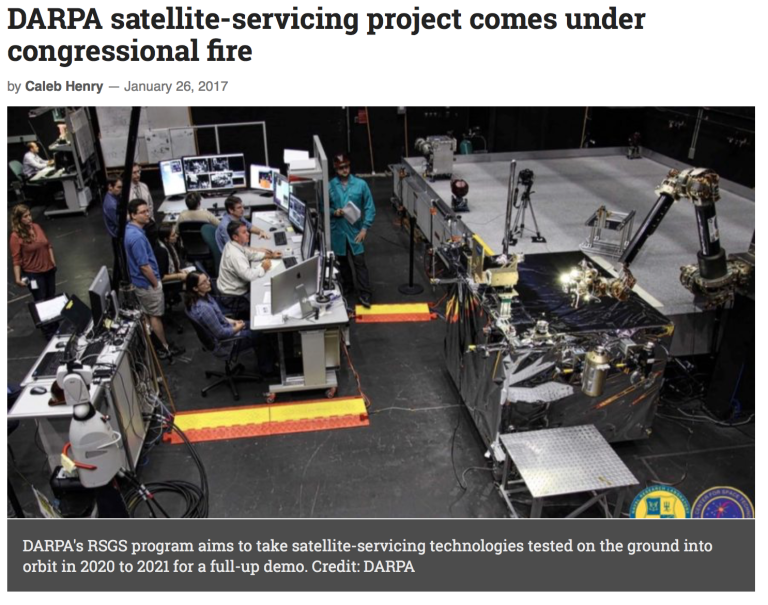
Not only were there congressmen questioning the RSGS mission as competition to commercial enterprise (presumably Orbital ATK), but the RSGS mission is also in competition with NASA’s Restore L mission, which seeks to develop refueling technology for GEO satellites. Orbital’s statement was in the Space News article as well as another article in Breaking Defense.
“DARPA’s RSGS program will subsidize a single company with several hundred million dollars’ worth of space hardware and launch service, courtesy of the U.S. taxpayer, to directly compete with commercial satellite servicing systems that Orbital ATK and other companies are developing with their own private capital. Even worse, we estimate that DARPA will provide about 75% of the program funding but retain only about 10% of its capability, a highly questionable and inefficient use of public funds,” Orbital ATK said. –
It is interesting that Orbital ATK did not bid on the RSGS effort with DARPA. I can easily see why in that the minimalistic approach of the MEV is not compatible at all with the Swiss pocket knife approach of DARPA and whoever its contractor is. Picture it like this.

My Opinion
Pictorially my opinion is the comparison image above. DARPA seeks to develop, since they have the toys around already (see their industry day presentation they have already designed most of the robotics that would be used) and are basically looking for partners to build a bus around it and a business case. Like a Swiss pocket knife, how many people actually use all the capabilities in all the knife appendages? In this case these appendages are exceptionally expensive and require a lot of use to recover the cost to design and build. The Orbital ATK/Skycorp/Effective Space Solutions approach is much more like the knife on the right, appropriate for the task that it is designed to carry out. It is absolutely inevitable that the GEO market is going to shift in the next several years, in ways that cannot today be forecast. It is far better and less business risk to build something simple that can address a known market that has already resulted in contracts and build from there.
At the end of the day, I think that RSGS is in GEO orbit the same thing that Orbital Express was in LEO orbit, a technical tour de force but a market failure in the marking. There is a significant advantage for the first mover to get to GEO with a system. I won’t go into the details of why, but it is the case. Thus if any of us get to GEO significantly before the 2021 initial operational date of RSGS, it will immediately be mostly obsolete. It is also expensive, it can’t help but be that way. The next DARPA chart shows why.
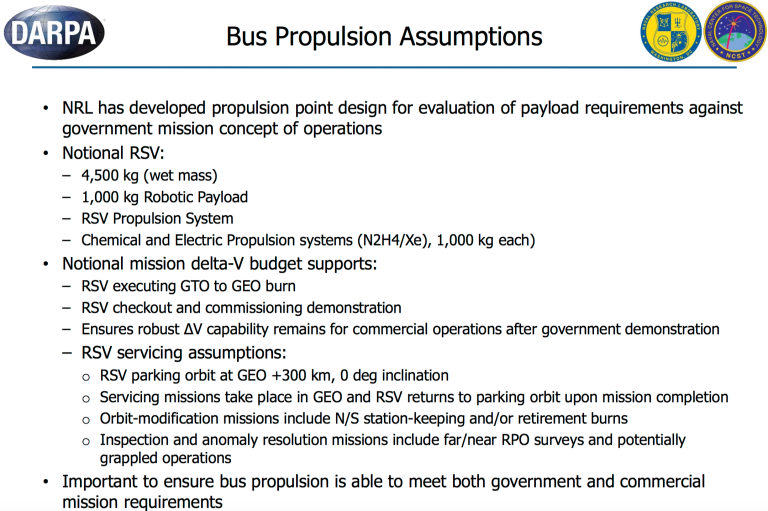
That is a fully fledged large GEO satellite equivalent. There is no way it can be cheaper than $350m dollars including launch and insurance, which they would be insane not to get. That is a lot of money and thus in the 5-8 year operational life they would have to do a minimum of $75-100m dollars in business per year to be profitable. Now this might be possible, but only if there are some substantial failures of GEO spacecraft solar array or antenna deployments in that time period. However, this is not sufficient for the changing nature of the space business.
The GEO market is under intense pressure to cut costs. The advent of hundred to possibly thousands of LEO satellites in constellations represents a fundamental challenge to the GEO business model that has been successful for 50 years. It is entirely possible that by the time that RSGS gets to orbit in 2021 that it is completely obsolete in terms of the market. That is the greatest threat. Thus Orbital ATK may be right about the inefficient use of funds, but for the wrong reason.

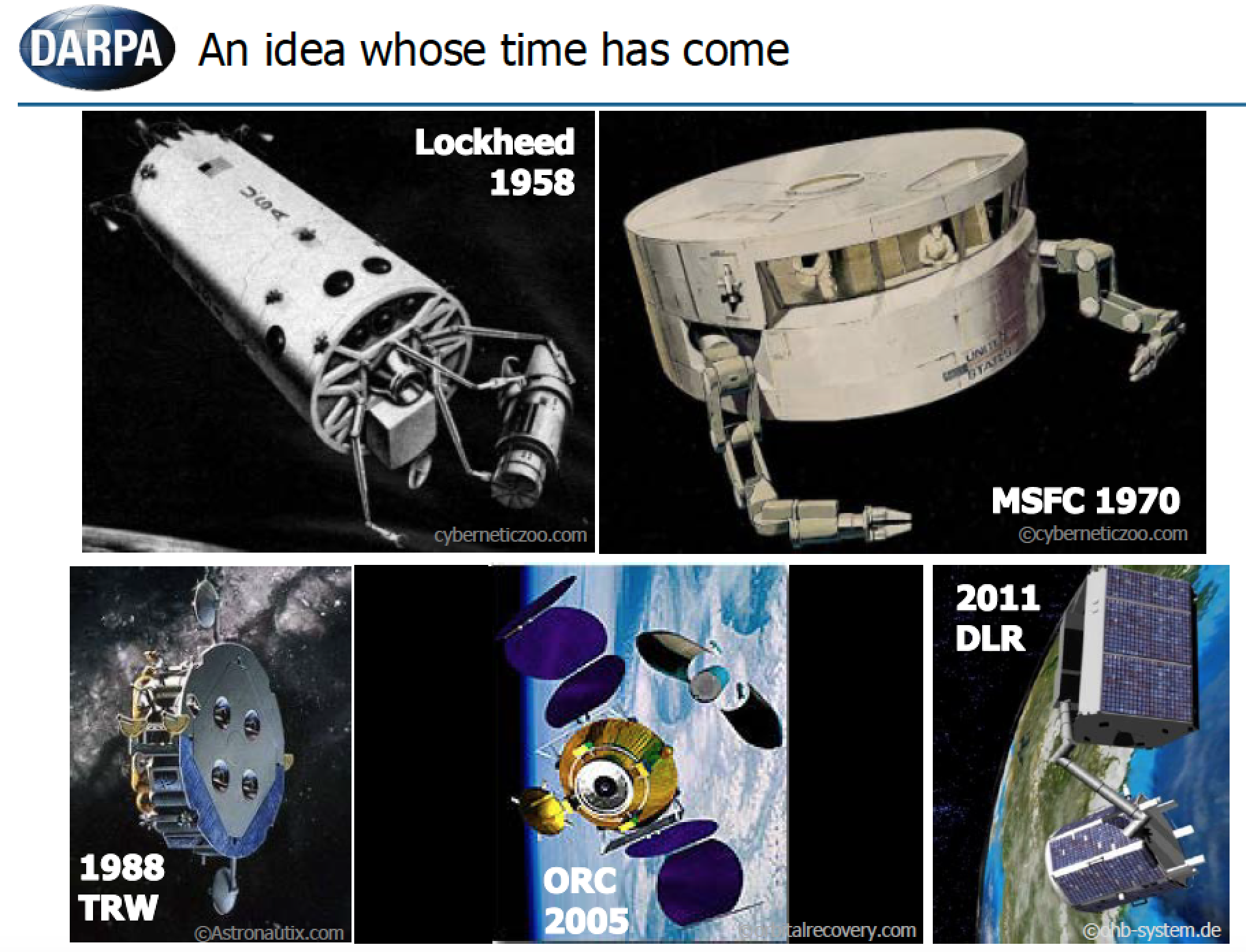
Seems a distinction between beginning of life service (ie warranty repairs) and end of life service might be useful in discussion.
End of life service business case might be improved if some sort of used satellite market existed.
First Hubble service mission accomplished much beyond just its science goals. It turned an ‘engineering space embarrassment’ into a fabulous advertisement for the usefulness of space. The human space component was very necessary to the accomplishments – science, engineering and public interest.
Sherry
Agreed. There is a quite robust market for used satellites in the industry and has been for decades. I also absolutely agree about how on orbit servicing helped to not only save, but to enhance and extend the useful life of the Hubble telescope. The NASA science community loved the concept so much they put their next telescope into an orbit that would all but preclude any possibility of fixing a problem with it!
I do think that there is room for both concepts. It is probably a large waste of the valuable resource of the RSGS type servicer to use it for graveyard and slot movements of GEO satellites. The value of that system is the robotics. For the Orbital/Skycorp/Effective Space solution, it is a minimalistic system that fills the gap that RSGS is too expensive to be utilized for.
One concern that should be addressed is – by servicing GEO satellites, will the DARPA system liberate debris? The “satlet” concept seems to have the potential to bump, etc existing satellites and potentially liberate pieces. Earlier concepts sounded like they would disassemble existing satellites in place, that would certainly liberate pieces.
Now the relative velocity with which they would spread out would be low, so they would most likely potentially affect the final, operational satellite.
I am sure that this point has been discussed at length in their systems development.
Dennis,
While as you say you’re responding here to the specific controversy brought on by the Congresspersons’ letter vis a vis RSGS, perhaps the larger
issue – for both RSGS and Restore-L is: Are these the ‘right’ government projects to incentivize/further jumpstart the larger spectrum of in-space servicing capabilities? I’ve had concerns that the answer is probably ‘not really’ for both the NASA and DARPA projects. But I do think the right type of government ‘help’ – and done in the right way – is indeed called for.
Both DARPA’s RSGS and NASA’s RESTORE-L have two things in common: 1) in both cases, the government is putting the priority on demonstrating in-orbit on an unmodified existing satellite; and, 2) each agency insists that the top priority be use its own, government-developed tools (such as the GSFC-developed storable refueling et al tools, and DARPA’s FREND arm) in the demonstrations. For each agency to insist that the primary purpose of spending the hundreds of millions (each) must be to demonstrate just their ‘in-house’ tools, only, is fundamentally the wrong tack(s) to take, if the goal is to be a direct contributor to helping jump-start a commercially sustainable space-servicing industry.
If NASA had taken that tack with the COTS/CRS programs – actually specifying what government-developed hardware to use, and how to go about using it, and nothing else – that very successful program to jump-start a LEO commercial cargo capability wouldn’t have succeeded. (Note, NASA did of course specify the use of the government-developed CBRMs (berthing mechanisms) and RMS (robotic arm-interface) systems, out of necessity, because that is what the ISS, the first customer, uses. But, nothing else about the design or operation of the rockets, spacecraft, or how they were used, was mandated by the government in any way).
In that way, it was the two corporate competitors who were responsible for determining what made economic sense to invest $$ in, build and operate – not the government. And they did what made economic sense, for them. And they developed dissimilar solutions – which was good. By putting the responsibility on the company’s wanting to provide services, it was left to them what to invest in that would make economic sense. While the current RESTORE-L and RSGS-models, where the primary thing is not (necessarily) what has economic legs, but rather, my-tools-must-be-used regardless, both require by far mostly government funding – with no type of assurance that either has economic legs, because economics was not the single most important driver.
That is why I called a meeting in Dec.2009 at GSFC with the GSFC satellite servicing team, the Senior Advisor for Commercial Space at NASA HQ, and myself; with my intention being to try to segue the conversation towards acting, COTS-like, in the direction of jump-starting a multi-competitor commercial space servicing industry; not an individual program to demonstrate the excellent tool suite GSFC had started developing as an extension of their Hubble experience. (I also brought along another Glenn Research Center electric propulsion expert to talk the side-subject of moving Hubble post-decommissioning to co-orbit with ISS). From the standpoint of my primary objective for calling the meeting, to persuade GSFC to move to the bigger role of doing a COTS-like, industry-jump-starting activity rather than primarily a prove-the-GSFC-tools activity, the 6-hour meeting was a marvelous effort— marred only by failure.
The main points thus apply I think to both NASA and DARPA efforts:
1. Government technology (including tools) development must have as their primary goal directly enabling (economically) sustainable industry capability; not the use of government GFE (government-furnished equipment), no matter what.
2. If government-developed technologies/tools were done correctly, one or more commercial companies will automatically incorporate them into their (commercially-based) designs. If they aren’t…..then they probably weren’t developed correctly, or at least, not in the correct way, which would involve commercial decision-making and ownership of final configurations as well as significant skin-in-the-game.
Dave Huntsman
David
Very interesting. Its clear that for both Restore=L and RSGS that NASA and DARPA had hardware that they wanted flown and were able to get funding to do it, by wrapping it in the warm embrace of claiming future commercial viability. I look at it similarly to you in that if we are going to do something like this, it should not be to pick winners, but to enable an industry. What Boeing, Lockheed, and the others are thinking is that if they get the contract, it will put them in the drivers seat in terms of the business. This may or not be true as it is keyed on how much skin that DARPA is requiring here. Considering the hardware that they want to fly and the bus size (4,000 kg) it is going to be a big and expensive system.
I have raised the same point with DARPA and others regarding the tools and technology in that if they want this to enable an a sustainable industry capability then they must release the hardware to the world as a global standard, or at least give it to any U.S. company that wants it. We are not the only ones doing this anymore and to act like it is some big national security give away is simply not living in the modern world.
Thanks for your intelligent comments.